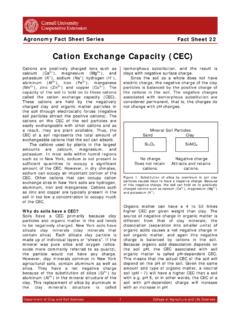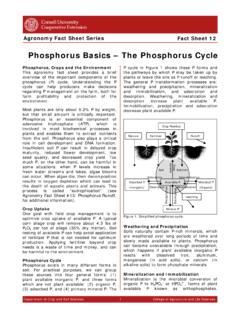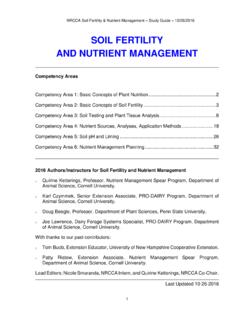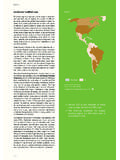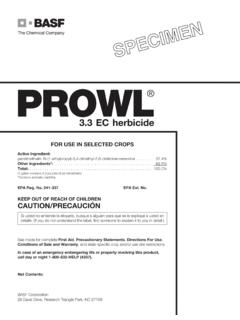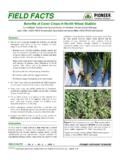Transcription of Nitrogen Fertilizers for Field Crops - Cornell …
1 Agronomy Fact Sheet Series Fact Sheet 44. Nitrogen Fertilizers for Field Crops Introduction prepared by mixing of ammonium nitrate and With the increased cost of Nitrogen (N) urea. It is primarily used as a non-pressurized fertilizer and concerns about the adverse liquid fertilizer and is for many the preferred environmental impacts of N losses, there is source of N for sidedressing of row Crops . UAN. great interest in fine-tuning N fertilizer can be broadcast or placed in the starter band. management. The goal is to match application If broadcast, UAN should be incorporated into source, rate, timing and method to supplement the soil as the urea portion is subject to on-farm sources of N ( , manure, soil volatilization. However, because of its lower %. organic N, sod, legume cover Crops ) to meet of N in urea and ammonium form, volatilization crop needs and achieve optimum levels of N losses per pound of N from UAN will be lower use efficiency.
2 Optimum N fertilizer than for urea. Banding with drop nozzles has management requires an understanding of the been found to minimize volatilization losses. different N Fertilizers . In this fact sheet we will The benefits of this product are its uniformity, discuss the basic properties of major N ease of storage, handling and application. Like fertilizer sources. urea, UAN will lower the pH because of conversion of ammonium to nitrate and Urea subsequent release of H+. Urea is a highly soluble, dry material. Its N. becomes plant-available when converted to ammonium (NH4+) and then nitrate (NO3-). Urea can be used as a starter, broadcast or topdress application and can be used in fertilizer mixes (dry or liquid). Advantages of urea are its high N content (45 to 46%), relatively low cost per lb of N, and rapid conversion to plant-available N.
3 If urea is surface applied and not incorporated (either by rain or tillage), N losses to the air (as ammonia) can approach 40% of the applied N. In addition, a rapid pH increase after application caused by hydrolysis of urea can result in ammonia release that can damage seedlings if the urea is applied too close to the Figure 1: Urea ammonium nitrate in liquid form is a seed. If urea is used as a band-applied starter, commonly used fertilizer to sidedress corn. the planter should be carefully checked to ensure placement is not closer than 2 inches Ammonium Sulfate beside and below the seed, and be calibrated Ammonium sulfate is a soluble, readily to apply no more than 60 lbs urea per acre (30 available source of N and sulfur (S). Dry forms lbs of actual N from urea). Conversion of contain 21% N and 24% S, while liquid forms ammonium to nitrate results in the formation have an analysis of 8-0-0-9.
4 Ammonium of hydrogen ions (H+), so, like most N sulfate can either be broadcast or applied in Fertilizers , repeated urea applications will the starter band. In high P and K fertility cause a reduction in soil pH over time. situations, many NY producers use ammonium sulfate alone in the starter band. Ammonium Urea Ammonium Nitrate sulfate is well-suited as a topdress application Urea ammonium nitrate (UAN) is a soluble, as it has a lower N volatilization risk than readily available N source with 28-32% N surface-applied urea. Also, where S is needed, Field Crops Extension 1 College of Agriculture and Life Sciences ammonium sulfate is a good source of S. that contains readily available sources of N. The drawbacks to using ammonium sulfate (18%) and P (46%). Formation of free include a relatively high salt index and greater ammonia produced after mixing of DAP with acidification potential per unit N applied than soil can cause seedling injury as described for other ammonium-containing N sources, higher urea.
5 To prevent such injury using DAP, it is cost per lb of N, and relative low N content, recommended to limit band-applications to (1). requiring more frequent refilling of hoppers. 65 lbs per acre of DAP, or (2) 30 pounds of urea N plus N from DAP. Anhydrous Ammonia Anhydrous ammonia has the highest Chilean Nitrate percentage of N of all Fertilizers (82% N) and Chilean nitrate can be used in conventional tends to be the cheapest N source (cost per and organic cropping systems (permitted for unit N). It is a high-pressure liquid that can be use by USDA/NOP in 2003). It contains 16% of deep-banded before, at or after seeding a readily plant-available form of nitrate-N and provided that there is no direct seed contact. sodium. It is available in a dry, flowable prill Anhydrous ammonia must be injected 6 to 8 form.
6 Inches deep into moist and friable soil to limit ammonia loss (liquid ammonia converts to gas Enhanced-Efficiency Nitrogen Sources when no longer under pressure). It must be Enhanced efficiency N sources are designed to stored under high pressure, which requires reduce losses of N due to leaching, specially designed, well-maintained equipment denitrification and/or volatilization. For more and facilities should be well-protected for information on these enhanced-efficiency safety reasons. During application, personal Fertilizers see Agronomy Fact Sheet #45. protective equipment (gloves and goggles). should be used. Concluding Remarks Applying the right source of N fertilizer at the Ammonium Nitrate right rate, time, and place is critical to proper Ammonium nitrate is an odorless salt with 33 N management.
7 For the best results, apply N. to 34% N. It can be surface-applied or only when needed, calibrate application incorporated into the soil. It contains both equipment to ensure proper placement, and ammonium and nitrate resulting in reduced adjust source, rate and timing to meet N needs volatilization risk as compared to urea, and the and avoid seed or seedling injury. nitrate provides a directly available N source. Since it contains ammonium, this fertilizer also Additional Resources lowers the pH of the soil. o Nutrient Management Spear Program Agronomy Fact Sheet Series. Potassium Nitrate Potassium nitrate, also known as saltpeter or Disclaimer This fact sheet reflects the current (and past) authors' best nitric acid, is considered a specialty fertilizer. It effort to interpret a complex body of scientific research, is a colorless transparent crystal or white and to translate this into practical management options.
8 Powder with 14% N and 46% potassium (K). Following the guidance provided in this fact sheet does not assure compliance with any applicable law, rule, regulation Potassium nitrate does not lower the soil pH. or standard, or the achievement of particular discharge levels from agricultural land. Mono-Ammonium Phosphate Mono-ammonium phosphate (MAP) contains For more information readily available sources of N (11%), P (52%). and S ( ). MAP is a dry granular material that is applied alone or often blended with other materials such as potash. It can be broadcast, band-applied or placed in the seed Nutrient Management Spear Program furrow. MAP can lower the soil pH but is an excellent starter fertilizer. John Weiss, Tom Bruulsema (IPNI), Mike Hunter, Di-Ammonium Phosphate Karl Czymmek, Joe Lawrence, Quirine Ketterings Di-ammonium phosphate (DAP) is dry fertilizer 2009.
9 Field Crops Extension 2 College of Agriculture and Life Sciences


